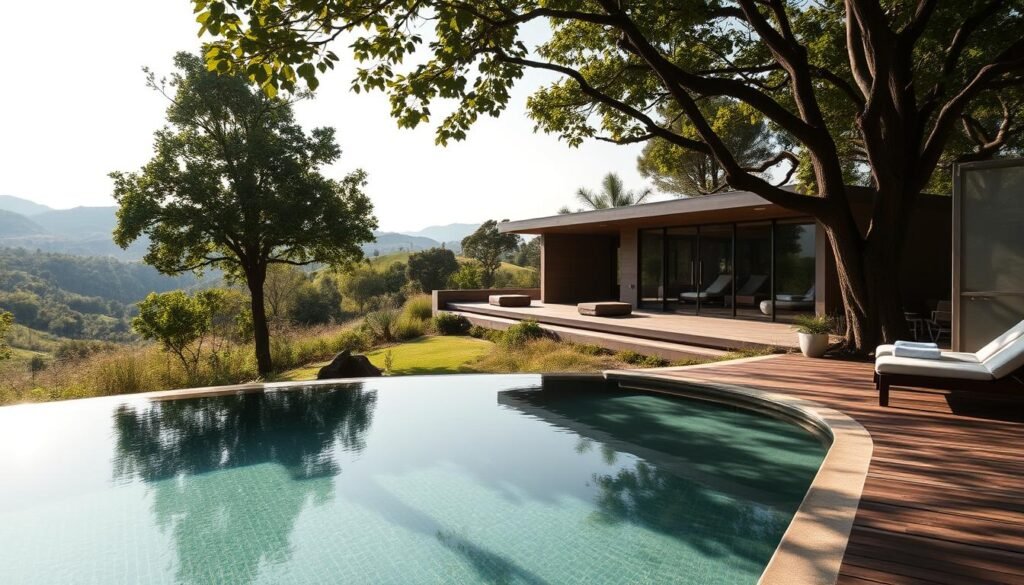In today’s fast-paced world, taking a break for self-care is more important than ever.
When people look for ways to rejuvenate and refresh, they often hear about “spa” and “wellness retreat“. But these terms mean different things.
A wellness retreat goes beyond just relaxation. It includes fitness, nutrition, and mindfulness activities. These are often set in a peaceful natural setting.
Key Takeaways
- Understand the core differences between spas and wellness retreats.
- Discover the benefits of choosing a wellness retreat for self-care.
- Learn how to select the perfect retreat based on your needs.
- Explore the variety of activities and services offered.
- Find out how to make the most of your retreat experience.
Understanding the Self-Care Spectrum
Self-care is now a key part of our health in today’s world. It has changed a lot, showing how society values wellbeing more.
The Evolution of Self-Care Practices
Self-care isn’t new, but it’s more popular now. There are many ways to practice it, from simple relaxation to full wellness programs. Spas and wellness retreats lead the way, offering experiences that meet our unique needs.
The Growing Wellness Industry in America
The wellness industry in America is booming. Spa treatments and wellness retreats are big parts of it. This shows a big change in our culture towards health and wellbeing.
| Year | Wellness Industry Size (in billion USD) | Growth Rate (%) |
|---|---|---|
| 2018 | 52.5 | 6.5 |
| 2019 | 55.8 | 6.3 |
| 2020 | 60.2 | 7.8 |
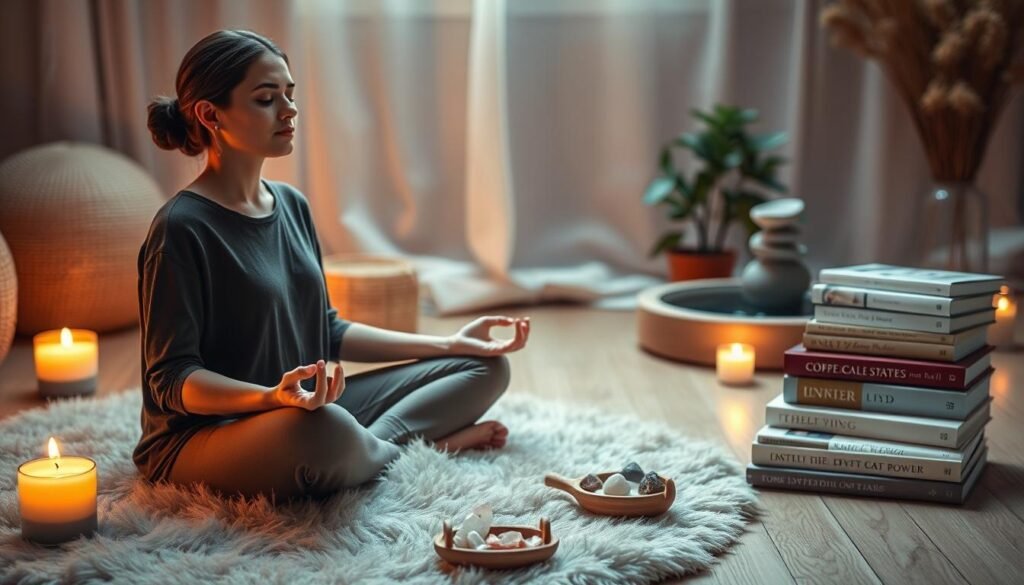
What Exactly Is a Spa?
Spas are special places for self-care, offering a calm break from daily life. They are where people go to unwind, refresh, and enjoy various treatments for their health.
Traditional Spa Services and Treatments
Spas provide many services like massages, facials, and body wraps. These help people relax, improve blood flow, and boost health. Some spas even offer unique treatments like aromatherapy and reflexology.
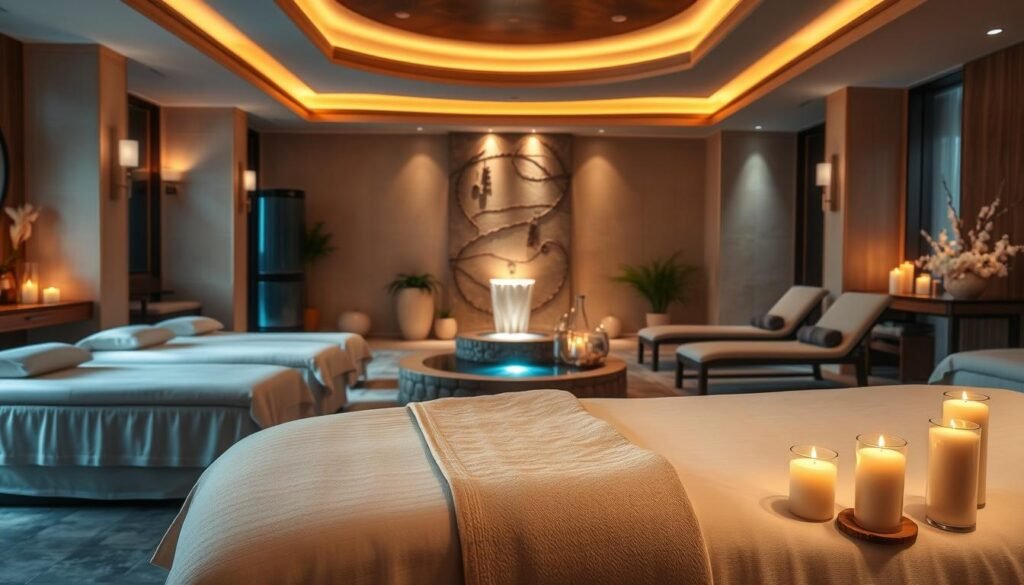
Types of Spas in the United States
The U.S. has many types of spas. There are luxury resort spas, day spas, and medical spas. Resort spas offer a full experience with rooms and wellness programs. Day spas are great for a quick visit. Medical spas focus on treatments like Botox and laser hair removal.
The Typical Spa Experience
A spa visit is meant to be calming and refreshing. Guests get a warm welcome and a drink. They choose treatments, use facilities like saunas, and end with quiet time.
Defining Wellness Retreats
Wellness retreats are changing how we care for ourselves. They offer deep experiences that help our bodies and minds. Unlike regular spas, these retreats focus on long-term health, not just quick fixes.
Core Philosophy of Wellness Retreats
The main idea behind wellness retreats is holistic wellbeing. They mix physical, mental, and spiritual health. This helps people connect more deeply with their health.
Common Components of a Wellness Retreat
Wellness retreats have many programs and activities. Some include:
- Nutrition workshops
- Yoga and meditation sessions
- Outdoor activities like hiking or kayaking
- Educational seminars on health and wellbeing
Together, these parts create a transformative experience. It’s more than just relaxing.
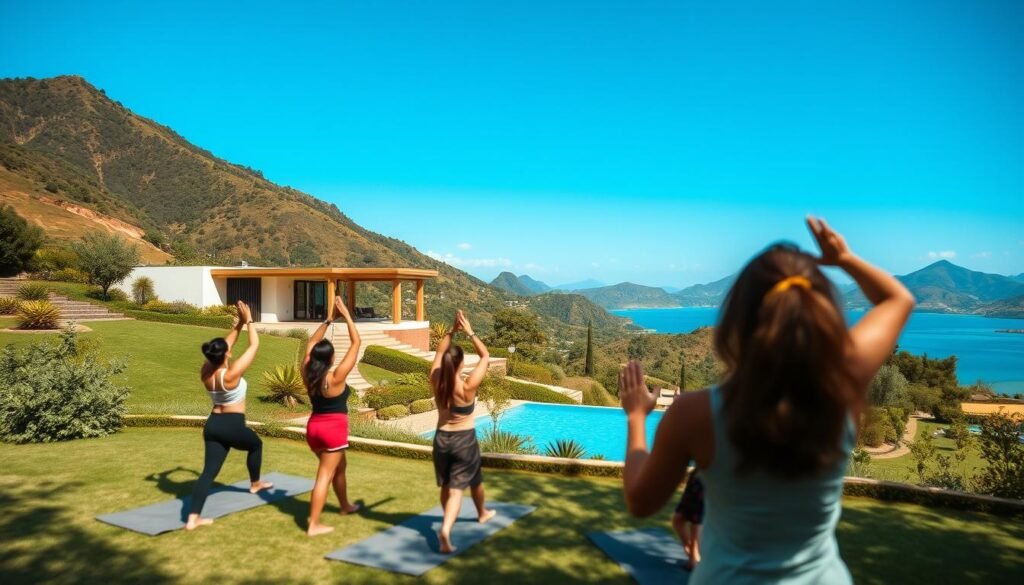
The Holistic Approach to Wellbeing
A big part of wellness retreats is their holistic approach to wellbeing. They don’t just focus on the body. They also care for the mind and spirit. This way, they offer a lasting path to better health.
In short, wellness retreats mix health practices with deep experiences. They aim for holistic wellbeing. Knowing their philosophy and parts helps us see their value in our health journey.
Spa vs. Wellness Retreat: Key Differences
Spas and wellness retreats have different ways to help you feel better. They vary in how long you stay and what services they offer. Both are popular for wellness, but they serve different needs and offer unique benefits.
Duration and Commitment
Spas usually offer short visits or stays. They let you relax and feel better without needing to commit for a long time. Wellness retreats, though, ask for a longer stay, sometimes weeks. They aim to help you make big changes in your life.
Focus and Intention
Spas focus on making you feel relaxed and pampered. They offer treatments like massages and facials. Wellness retreats, on the other hand, focus on your overall health. They combine physical activities, nutrition advice, and mental wellness practices.
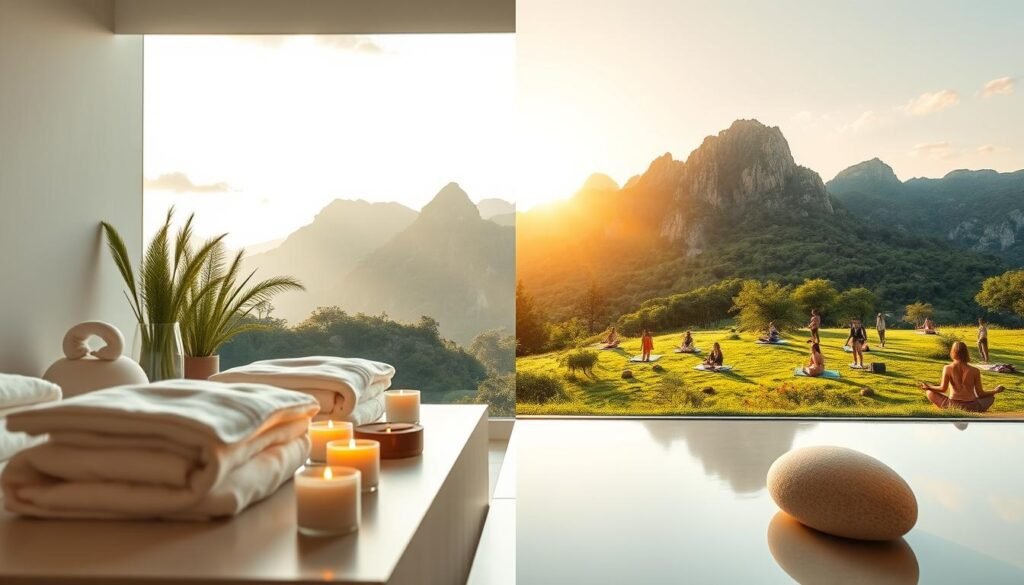
Services and Activities Offered
Spas have many traditional spa services like massages and saunas. Wellness retreats also offer these, but they focus more on health-promoting activities. These include yoga, meditation, and outdoor activities.
Expected Outcomes
Spas aim to give you immediate relaxation and stress relief. Wellness retreats, with their broader approach, aim for lasting changes. They want to improve your physical health, mental clarity, and overall wellbeing.
| Feature | Spa | Wellness Retreat |
|---|---|---|
| Duration | Short-term (day visits to a few days) | Long-term (several days to weeks) |
| Focus | Relaxation and pampering | Holistic wellbeing |
| Services | Massages, facials, beauty treatments | Yoga, meditation, nutritional guidance |
| Expected Outcome | Immediate relaxation and stress relief | Long-term lifestyle changes |
Wellness expert Dr. Axe says, “A wellness retreat is not just a vacation; it’s an investment in your health and wellbeing.” This shows why wellness retreats are different from spas.
The Purpose Behind Your Visit
Before you book a spa day or a wellness retreat, think about what you want to get out of it. Knowing your goals will help you choose the right place for you.
Relaxation vs. Transformation
Spas and wellness retreats serve different purposes. Spas focus on relaxation with treatments like massages and facials. Wellness retreats, on the other hand, aim for transformation. They offer a full approach to wellbeing, including exercise, nutrition, and mental health practices.
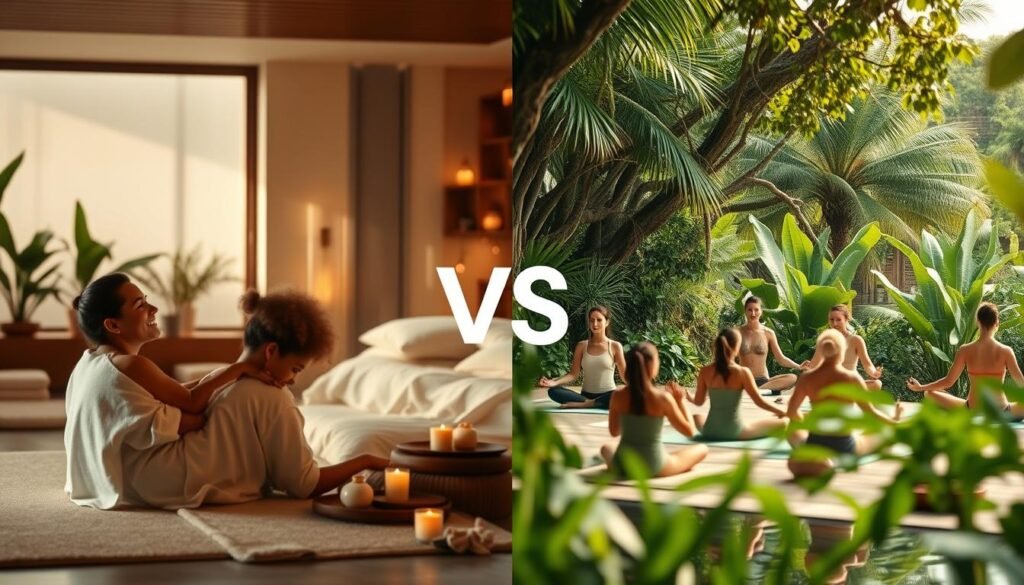
Quick Escape vs. Life Change
Visiting a spa or a wellness retreat can be a quick escape or a chance for a big life change. Spas are great for a short break. Wellness retreats are for those wanting to make lasting changes in their life or wellbeing.
Setting Intentions for Your Experience
Having clear intentions can make your visit better, whether it’s a spa or a wellness retreat. Think about what you want to achieve. Do you want to reduce stress, improve your health, or clear your mind? Knowing this will help you get the most out of your experience.
| Aspect | Spa | Wellness Retreat |
|---|---|---|
| Purpose | Relaxation and Rejuvenation | Transformation and Holistic Wellbeing |
| Duration | Typically a day or a few hours | Several days to a week or more |
| Focus | Treatments like massages and facials | Physical activity, nutrition, and mental wellness |
Comparing the Physical Environments
Spa and wellness retreats have different settings for various needs and tastes. The physical space greatly affects the experience.
Spa Settings and Atmospheres
Spas aim to create a peaceful and calming vibe. They use soothing decor like soft colors, gentle lights, and quiet water sounds. This setup helps guests relax and lower their stress levels.
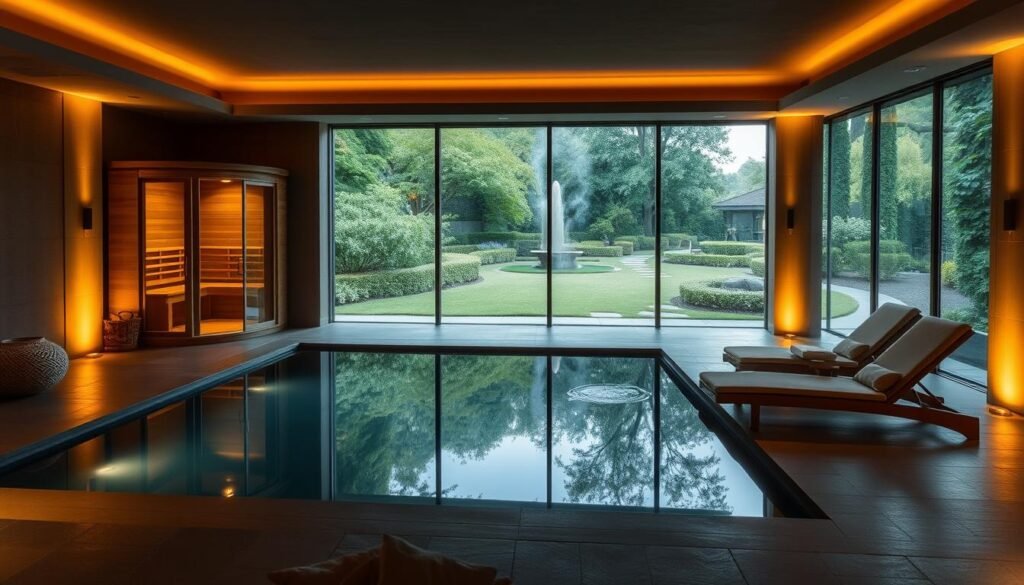
Wellness Retreat Locations and Accommodations
Wellness retreats are often in vast, natural spots. They might be in mountains, forests, or near the sea. This lets guests escape city life and connect with nature. The places to stay vary, from simple to fancy, based on the retreat’s style and who it’s for.
How Environment Impacts Your Experience
The setting of a spa or wellness retreat greatly shapes your experience. A well-thought-out space can make treatments more effective, help you relax, and build a sense of community.
Urban Spas vs. Remote Retreats
Choosing between an urban spa and a remote retreat depends on what you want. Urban spas are handy and easy to get to. Remote retreats offer a chance to fully disconnect and enjoy nature.
| Feature | Urban Spas | Remote Retreats |
|---|---|---|
| Location | City centers | Natural settings |
| Atmosphere | Modern, sleek | Natural, serene |
| Accessibility | Easy to access | May require travel |
Health and Wellness Approaches
It’s important to know about different health and wellness methods. This knowledge helps when choosing spa visits or wellness retreats. The health and wellness world has many practices and ideas. Each one aims to improve physical, mental, and emotional health.
Spa Treatments and Their Benefits
Spa treatments help with relaxation, rejuvenation, and overall health. They include massages, facials, and special therapies like aromatherapy and reflexology. These treatments can lower stress, improve blood flow, and make skin healthier.
Many spas offer treatments that fit your specific needs. This makes your experience more personal.
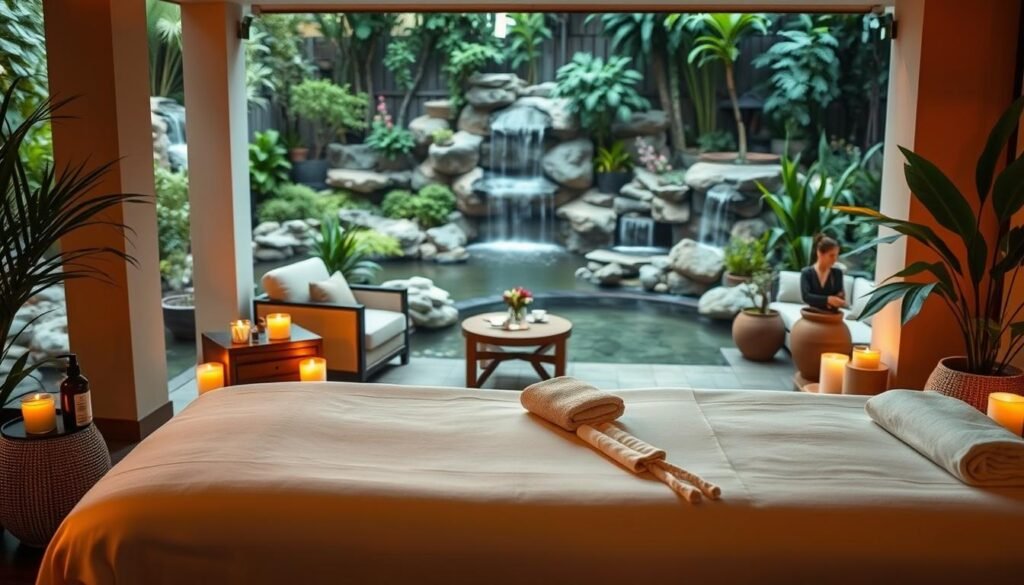
Wellness Retreat Health Philosophies
Wellness retreats take a holistic view of health. They mix mindfulness, nutrition, and exercise. These retreats last longer than spa visits, letting you dive deep into wellness.
The goal is to live a balanced life. You learn through yoga, meditation, and workshops on healthy living. This helps you connect with others and find self-awareness.
Medical Spas vs. Health-Focused Retreats
Medical spas and health retreats have different focuses. Medical spas use treatments like laser therapy and Botox for cosmetic improvements. Health retreats, on the other hand, focus on lifestyle changes and overall wellness.
Medical spas offer quick beauty fixes. Health retreats aim for lasting health changes.
Long-term Health Impacts
Spa treatments and wellness retreats can have lasting effects. Regular spa visits can reduce stress and improve health. Wellness retreats help with lasting mental and physical health improvements.
People often keep practicing what they learned at the retreat. This leads to ongoing health benefits.
In summary, spas and wellness retreats both offer valuable health benefits. Knowing the differences helps you choose what’s best for your health goals.
The Social Experience
The social side of a spa or wellness retreat can really change your experience. You might want to get away from daily life or meet new people. Knowing about the social side is key.
Solo vs. Group Experiences
Choosing to go solo or with friends depends on what you want. Solo travelers like the quiet time to think. Friends make it more fun with shared activities.
Solo experiences let you focus on yourself and set your own pace. Group experiences add friendship and motivation.
Community Aspects of Wellness Retreats
Wellness retreats value community. They create a space for people to support and inspire each other. Activities like group meditations and meals together help everyone feel connected.
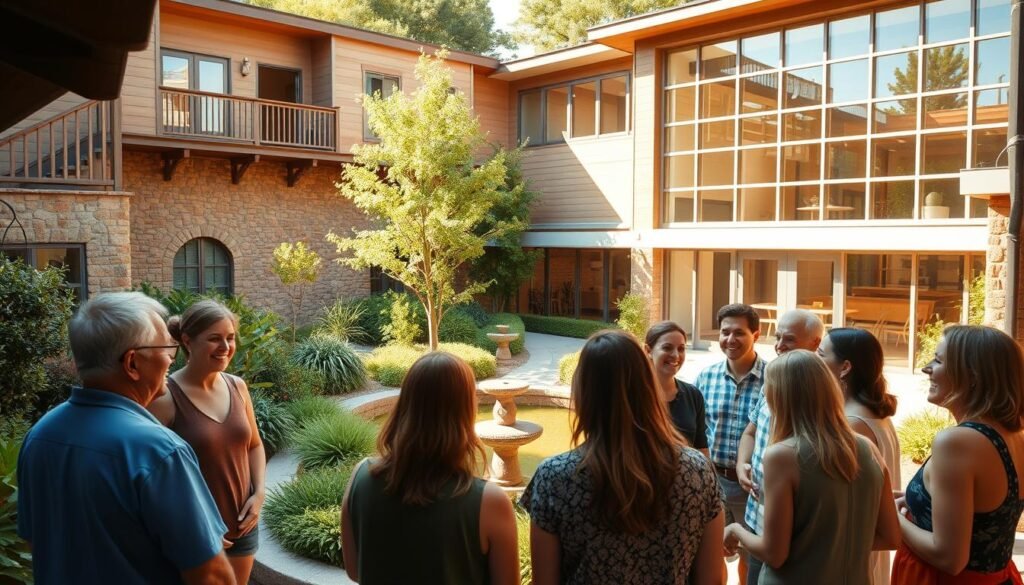
Building Connections Through Shared Wellness
Wellness experiences can lead to lasting friendships. Working together towards health goals creates strong bonds. As one expert says,
“The connections made during a wellness retreat can be just as transformative as the treatments and activities.”
Choosing a retreat that fits your social style can make your experience better. You might even make friends that last.
Investment Considerations
Investing in your wellbeing through a spa or wellness retreat is a big decision. You need to understand the costs involved. Spas and wellness retreats offer different benefits, but their prices and value can vary a lot.
Typical Costs of Spa Treatments
Spa treatments range from simple massages to complex packages. The costs of spa treatments depend on location, service, and how long it lasts. For example, a day at a luxury spa might include:
- Massages ($100-$250 per session)
- Facials ($150-$300 per treatment)
- Body wraps and scrubs ($100-$200 per treatment)
Packages and memberships can make it cheaper to enjoy more services.
Pricing Models for Wellness Retreats
Wellness retreats often have an all-inclusive pricing model. This means they cover everything from accommodations to meals and activities. Prices vary based on the retreat’s length, location, and luxury. A week-long retreat can cost from $1,500 to $5,000 or more per person.
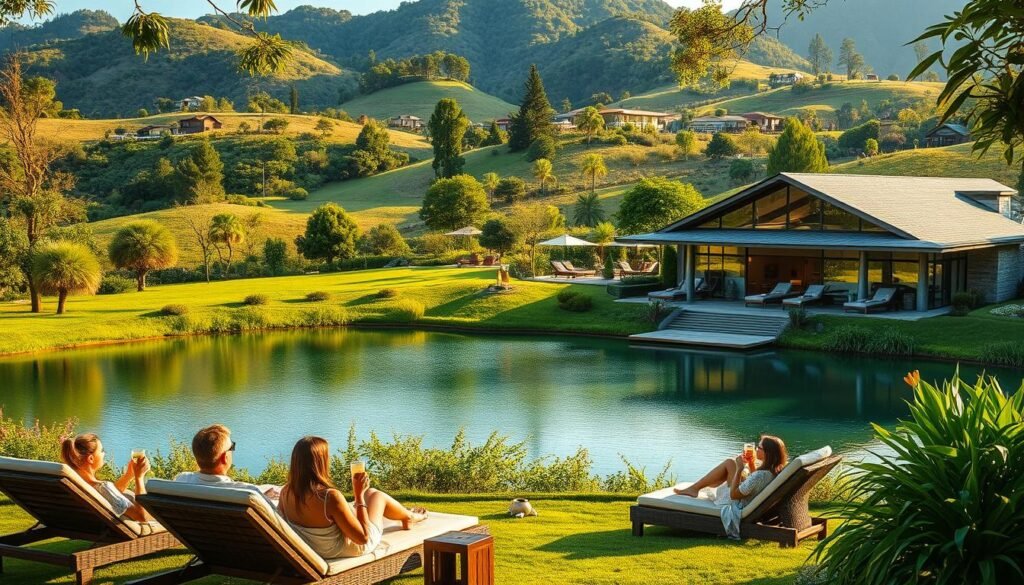
Value Assessment: Short-term vs. Long-term Benefits
When looking at the value of a spa or wellness retreat, think about both short-term and long-term benefits. Short-term benefits include relaxation and rejuvenation. Long-term benefits might include lasting lifestyle changes and better overall wellbeing.
Budgeting for Your Wellness Journey
Budgeting for a spa or wellness retreat is more than just looking at the upfront costs. It’s also about the long-term savings and benefits, like lower healthcare costs. To budget well, consider:
- Setting clear wellness goals
- Researching options to find the best value
- Planning ahead to take advantage of early booking discounts
- Considering off-season or package deals
By carefully evaluating your options and planning your expenses, you can make informed decisions. This supports your wellbeing goals without overspending.
How to Choose the Right Option for You
It’s important to know what you need and want when choosing between a spa or wellness retreat. Think about your goals and what you want to get out of the experience.
Assessing Your Personal Needs
Start by thinking about what you’re looking for. Do you want to relax, or are you looking for a big change? Ask yourself these questions:
- How stressed are you and how much relaxation do you need?
- Do you have fitness goals that need a structured plan?
- Are there any health concerns or wellness goals you want to tackle?
Questions to Ask Before Booking
Before you book, ask the right questions. Find out about:
- The qualifications and experience of the staff
- The variety of treatments and activities they offer
- The types of accommodations and amenities they provide
Red Flags to Watch For
Watch out for places that:
- Have bad reviews or are unclear about their services
- Make promises they can’t keep
Researching Credibility and Reviews
It’s key to check if a spa or wellness retreat is credible. Look for genuine reviews from different places. Also, make sure they have the right credentials and certifications. A good place will be open and clear about their policies and communication.
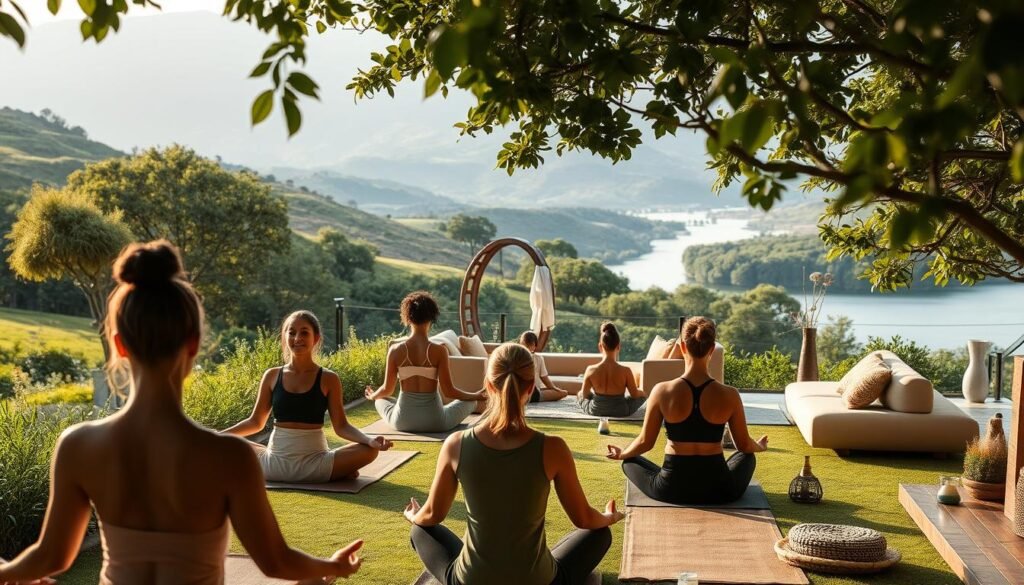
Preparing for Your Experience
Getting ready for a spa day or wellness retreat is more than just booking a spot. It’s about creating a space for relaxation and renewal. To fully enjoy your visit, preparation is key.
What to Pack for a Spa Day
For a spa day, pack a few must-haves for comfort and fun. Bring a swimsuit, comfy clothes, and a book. Some places might even offer robes and slippers.
- A swimsuit for pool or hot tub use
- Comfortable clothing for relaxation
- A book or magazine for downtime
- Personal care items like hair ties or makeup
How to Prepare for a Wellness Retreat
Wellness retreats need more planning since they’re a bigger commitment. Think about what you want to achieve, like relaxation, detox, or fitness. Bring yoga mats, healthy snacks, and comfy workout clothes.
| Item | Purpose |
|---|---|
| Yoga mat | For yoga or meditation sessions |
| Healthy snacks | To maintain your dietary regimen |
| Comfortable workout clothes | For fitness activities |
Setting Realistic Expectations
It’s important to know what to expect. A spa day is for unwinding, while a wellness retreat is deeper, focusing on your overall health. As Dr. Jane Smith, a wellness expert, says, “The success of a wellness retreat depends on your mindset.”
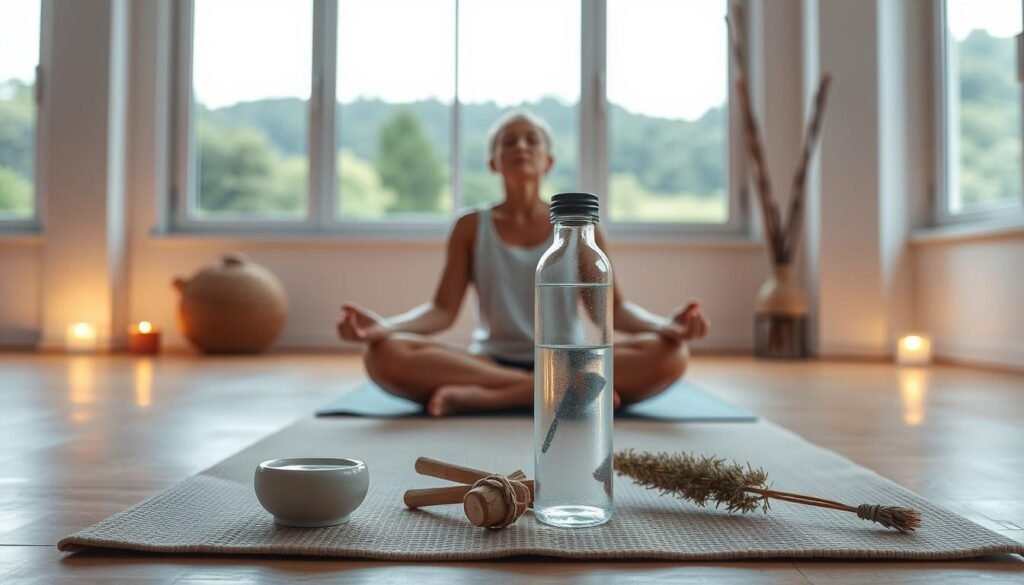
With the right preparation and expectations, you’ll get the most out of your spa or wellness retreat.
Conclusion
Spas and wellness retreats serve different needs and offer unique experiences. It’s important to understand the differences to make the right choice for your self-care goals.
Think about what you want to achieve. If you’re looking for relaxation and specific treatments, a spa might be best. For a deeper experience that covers physical, mental, and emotional wellbeing, a wellness retreat could be better.
In the end, choose what fits your wellness goals. Whether it’s a spa or a wellness retreat, the right choice will help you improve your wellbeing and life quality.

